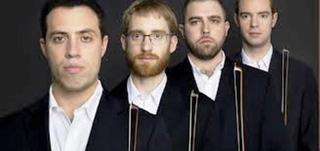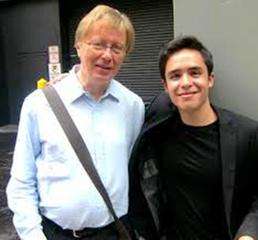|
Back
Cries and Whispers New York
DiMenna Center for Classical Music
08/18/2018 -
“TIME:SPANS”:
Felipe Lara: Tran(slate)
Sabrina Schroeder: UNDERROOM (World Premiere)
Georg Friedrich Haas: String Quartet No. 7 (U.S. Premiere)
JACK Quartet: Christoper Otto, Austin Wulliman (Violins), John Pickford Richards (Viola), Jay Campbell (Cello); Live Electronics: Caley Monahon-Ward (TIME:SPANS 2018); SWR Experimentalstudio Freiburg, Germany: Detlef Heusinger (Artistic Director,), Lukas Nowok

C. Otto, A. Wulliman, J. P. Richards, J. Campbell
“I want to express myself. I trust my sensations. I try to find out how sound and colour and time and dynamics fit together. I do not have any system. I do not trust systems at all.”
Georg Friedrich Haas
These five days of music by the Earle Brown Foundation ended not with a bang (though we had plenty of those) but with whisper, a cry, an explosion or two, reverbs in a Minotaur-sized cave, and, yes, a whimper.
The first night consisted of a mere string quartet. Last night, the electronic/digital folks took over. Specifically the engineers of Germany SWR Experimentalstudio. Not that they were actually necessary. No mere electronic studio can create the notes which JACK Quartet can make with eight mere hands on their fiddles. Whether the almost inaudible murmuring of Sabrina Schroeder’s UNDERROOM or the sawing and fretting and quantum-spaced volume changes of that fine Brazilian composer Felice Lara’s Trans(late), or–most stunnng of all–Georg Friedrich Haas’ plainly named 7th String Quartet–the JACK Quartet can handle every sound, timbre, rhythm and newly invented operandi of producing their sounds.
Yet these works, after which each composer appeared, became a duet for the players on stage and the dialers behind the huge consoles. They never became the dominant artists–that was reserved for the JACK–but the sounds came from around the auditory chambers in the DiMenna Auditorium.
Those pulses, ring modulations, sequences and reverbs were the complements, but they were around only when we needed them.
Mr. Lara’s Trans(late) was an example. The title came from the classical guitarist’s “impossible desire/obsession from starting from a blank state...to create encounters, clashes superpositions and transitions...”
That slate was never exactly blank. The JACK Quartet started off with a weird bang, with a very strange sound. Were they bowing on the bridge of their instruments? Were they playing between the tailpiece and the bridge? I couldn’t figure it out, but the eight connected sections were fairly chaotic, backed up by those ghostly reverbs from the back of the room, and holding one’s attention.
Attention to what? Ah, that was Mr. Lara’s secret. Yet this was a fascinating musical secret to his own inspired world.
I read no program notes of Ms. Schroeder UNDERROOM, from that extremely beautiful program-book put out by the Earle Brown Foundation. All I knew was that the never-ending whispering from the fiddles, along with an occasional howl from the digitalizers, didn’t exactly draw me.
Later I read that the electronics came from a “hug machine” developed by one Temple Grandin. This isn’t musical per se, but (says Google) a machine developed for autism. In this case, Ms. Schroeder was yearning for “the enveloping space that sound and sound-feel came make with bodies.”
Perhaps in an empty room, that would have made more sense. Here, in a full-house of ardent listeners, the vibrations were diffused, the splendid hushed playing seemingly endless.

G. F. Haas, J. Campbell (© Sam A. Dog)
Of course Mr. Haas’ Seventh String Quartet was, in length (close to 30 minutes) and layer upon layer of creativity, the most fascinating work. As for the performers, Mr. Haas wisely adheres to the JACK Quartet for virtually all his chamber music. Add to that no less than ten various machines, ranging from midi controllers, to MacBook Pro to four amplistring fixings for the lavalier microphones.
Forget that all. The end result was more than absorbing. It was a gripping study in microtones, with nearly every measure reverbed and echoed by eighth-divisions on the strings. In energy, the players and the digital sounds partnering in surprising movements. And in clusters which transcended music.
I realize that one should not give vent to extra-music imagination. But I had the primary vision of our schoolbook pictures of the atom, all nicely revolving with a nucleus here and an electron or two there. And then the reality of the atom, which has none of the above yet exists with pure energy, pulsing, movements and spaces which can’t exist simultaneously.
The first was classically beautiful, Mozart, Haydn Raphael. The second was Mr. Haas, whose microtones, glissandi and sonic landscape could never be still, with equations that could never be solved.
Add to this Mr. Haas’ respect for (wait for it) the tune. The melody. First on cello, then on two violins a microtone apart, then in unison by all the instruments with the digital sounds overpowering us from the back.
No explanations were necessary here. Mr. Haas resists being called a “spectral” composer or any other title. He simply composes, using music, light, digital sounds and sheer darkness.
He, the JACK Quartet and the digital masters gave this String Quartet what is so frequently omitted in digital-sized music. Life, organic life. Perhaps hidden under layers of incoherent opacity, perhaps as startling as it is splendid. Yet somehow penetrating into our deepest aural sensibilities.
Harry Rolnick
|